【资料】跨文化交际课程unit4汇编
- 格式:ppt
- 大小:2.02 MB
- 文档页数:42
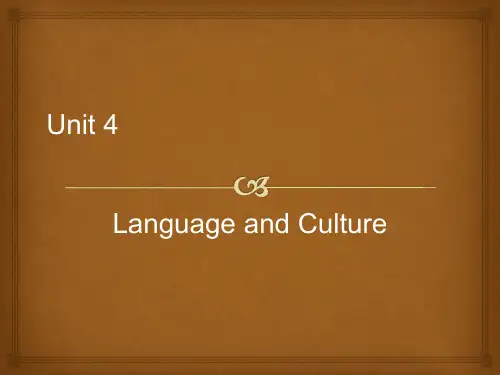
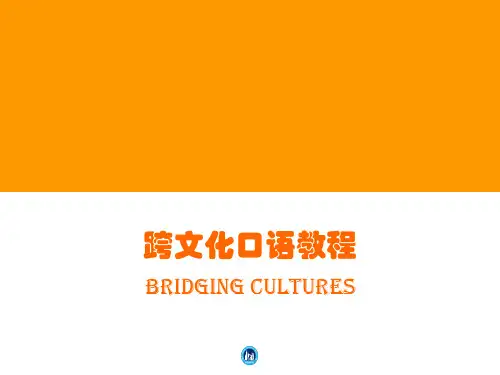

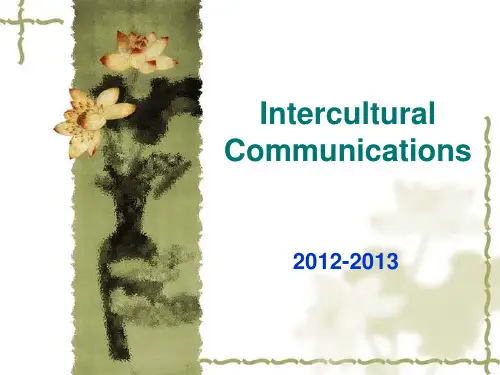

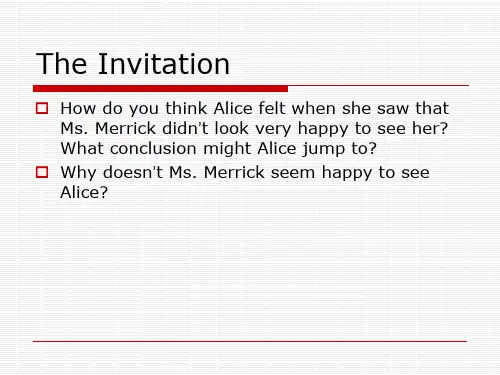
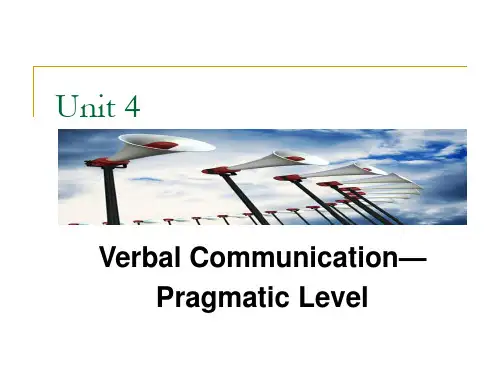
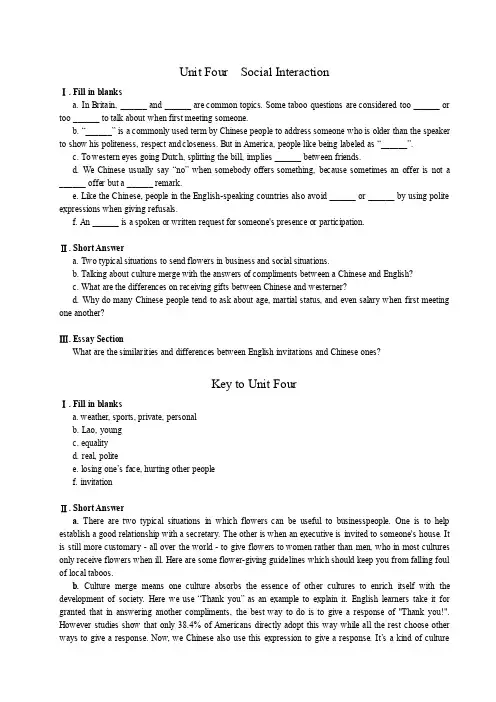
Unit Four Social InteractionⅠ. Fill in blanksa. In Britain, ______ and ______ are common topics. Some taboo questions are considered too ______ or too ______ to talk about when first meeting someone.b. “______” is a commonly used term by Chinese peop le to address someone who is older than the speaker to show his politeness, respect and closeness. But in America, people like being labeled as “______”.c. To western eyes going Dutch, splitting the bill, implies ______ between friends.d. We Chinese us ually say “no” when somebody offers something, because sometimes an offer is not a ______ offer but a ______ remark.e. Like the Chinese, people in the English-speaking countries also avoid ______ or ______ by using polite expressions when giving refusals.f. An ______ is a spoken or written request for someone's presence or participation.Ⅱ. Short Answera. Two typical situations to send flowers in business and social situations.b. Talking about culture merge with the answers of compliments between a Chinese and English?c. What are the differences on receiving gifts between Chinese and westerner?d. Why do many Chinese people tend to ask about age, martial status, and even salary when first meeting one another?Ⅲ. Essay SectionWhat are the similarities and differences between English invitations and Chinese ones?Key to Unit FourⅠ. Fill in blanksa. weather, sports, private, personalb. Lao, youngc. equalityd. real, politee. losing one’s face, hurting other peoplef. invitationⅡ. Short Answera.There are two typical situations in which flowers can be useful to businesspeople. One is to help establish a good relationship with a secretary. The other is when an executive is invited to someone's house. It is still more customary - all over the world - to give flowers to women rather than men, who in most cultures only receive flowers when ill. Here are some flower-giving guidelines which should keep you from falling foul of local taboos.b. Culture merge means one culture absorbs the essence of other cultures to enrich itself with the development of society. Here we use “Thank you” as an example to explain it. English learners take it for granted that in answering another compliments, the best way to do is to give a response of "Thank you!". However studies show that only 38.4% of Americans directly adopt this way while all the rest choose other ways to give a response. Now, we Chinese also use this expression to give a response. It’s a kind of culturemerge.c. In the West, it is regarded as polite to open gifts as soon as they are given to express appreciation. In China, the situation is quite the reverse. Normally we Chinese feel that if you open the gift as soon as it is given, you might embarrass the person who gives the gift and you might be thought greedy. Therefore, Chinese people tend to open the gifts after the visitors have left.In China, many people send gifts without wrapping them, and if they wrap them, they usually tell the receiver what is inside, and the receiver will thank the sender and put the gift aside without unwrapping them since they already know what is inside. English receivers open the gifts in front of the senders of the gifts.d. To them, these are open conversational topics. Knowing a person’s age helps them use appropri ate terms of address. And Chinese people pay a lot of attention to family life, so naturally talk of family members features as a common topic. As to salary, since there is a national system of salaries, people usually don’t consider it a secret and they talk about it openly.Ⅲ. Essay SectionIn order to keep the good relationship with others, people both in China and other countries will organize social activities and they will hold parties, banquets, celebrations, balls, opening ceremonies, closing ceremonies, wedding ceremonies as well as funerals. On these occasions, hosts are sending guests all kinds of invitations.Similarities:Both in Chinese and English invitations, there are formal and informal ones, and there are written and oral invitations.Invitations, especially the formal written ones both in English and Chinese, will have to be prepared in an acceptable styles The styles are usually fixed.The purpose, time, places, names of hosts, names of guests should be clearly written in the invitation.Both in Chinese and English invitations, there are formal and informal ones, and there are written and oral invitations.Invitations, especially the formal written ones both in English and Chinese, will have to be prepared in an acceptable styles The styles are usually fixed.The purpose, time, places, names of hosts, names of guests should be clearly written in the invitation. Differences:In an English invitation, generally speaking, both husband and wife will be inc luded. In a Chinese one, it is common that only one of the couple is invited.All formal English invitations are invariably in the third person, and good usage permits of no deviation from this form.The written styles in a Chinese invitation and an English one are different. In English the words are usually put in the center of the paper while in Chinese the format is somewhat is a letter.。
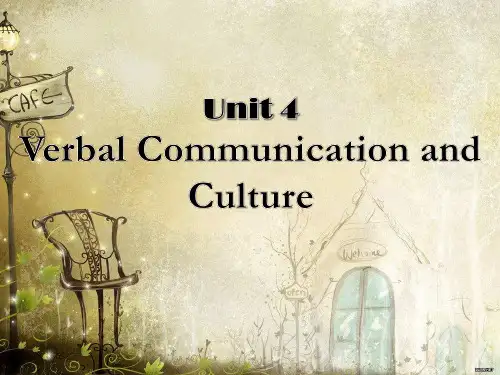
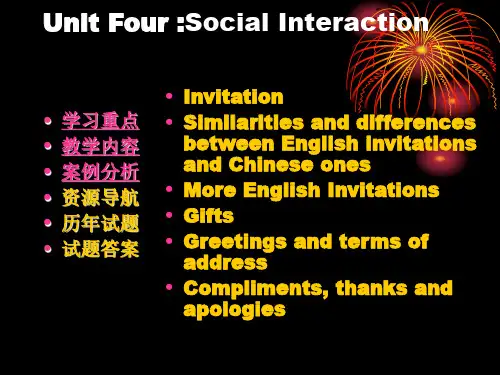
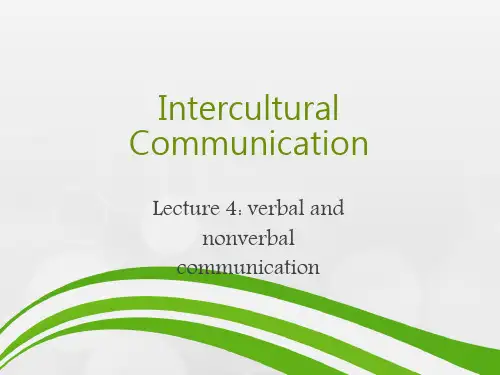
Unit 4 词汇与意义⏹教学内容:⏹(1)词汇的概念意义、内涵意义、社会意义、情感意义和搭配意义。
⏹(2)中英词汇对比⏹基本要求:⏹了解词汇在语言的跨文化交际中的地位,掌握词汇的几种意义,中英语言在词汇方面存在的差别。
重点是词汇的内涵意义及中英词汇的差别。
Importance⏹If we want to study the difference between two languages, we have to begin with the study of the words in the two languages. Because the close relationship between language and culture is most readily seen in words.Section 1 T ypes of meanings⏹1. Conceptual meaning概念意义⏹the basic meaning presented by a word. It refers to logical, cognitive(认知的), referential (指示的), or denotative(外延的)content.⏹also known as surface meaning or denotative meaning外延意义, dictionary meaning or literal meaning字面意义of a word.Features of Conceptual meaning概念意义⏹1. It is the core of the meaning of a word. It is the basic meaning represented by meaningful linguistic units. It‟s recorded in the dictionary.⏹E.g. woman-an adult female human being.⏹Dog-a four-legged animal which can make the sound of barking⏹2. It can be divided into some semantic components(语义成⏹分).⏹Woman: +animate(有生命) +human(人) - male (男性) -adult(成年)I⏹boy:⏹3. It is relatively constant and stable, because it is the meaning agreed upon by all the members of the same speech community.But it may also vary.⏹Manuscript =“手稿” now also including文稿printed from typewriter or computer Note: Many different words can have the same conceptual meaning⏹walk⏹to move forward by placing one foot in front of the other. The newlyweds新婚夫妇strolled down漫步the streets of Paris.⏹The wealthy businessman swaggered大摇大摆地into the restaurant and demanded a table.The overweight man lumbered笨重地行动along, breathing heavily and occasionally tripping.⏹These synonyms, although with different connotative meanings内涵意义, have the same conceptual meaning.The English Words unique in English culture⏹A. words related with geography⏹e.g. New England, Canberra, Northern Ireland, Sydney, London, Edinburgh, Greenwich, Quebec, Ottawa,⏹The Thames River, St. Lawrence, British Isles, The Rocky Mountains(落基山脉), The Mississippi River, The Niagara Falls,⏹koala, kangaroo, tornado(龙卷风)⏹The Great Barrier Reef, Silicon V alley, Yellowstone Park,⏹Summary:All these have their own geographical features: places, plants and animals uniquely found in USA, Great Britain and Australia; They all represent meaning unique in their own cultures;Their Chinese equivalents are only used by the Chinese people as mere names, which have lost their distinctive geographical and cultural features.The English Words unique in English culture⏹A. words related with geography⏹e.g.⏹U.S.A: New England, The Rocky Mountains,The Mississippi River, The Niagara Falls,Y ellowstone Park, Silicon V alley⏹Britain: British Isles, Northern Ireland, London, Edinburgh, Greenwich, The Thames River, Rose⏹Canada: Ottawa, Quebec, St. Lawrence,⏹Australia: Canberra, Sydney, The Great Barrier Reef, koala, kangaroo⏹B. words and history⏹the May Flower⏹(the ship in which a group of⏹British Puritans who were also⏹known as pilgrim fathers sailed to⏹America in 1620.⏹The revolutionary war⏹( the struggle of the 13 colonies in North America for independence from the British rule between 1775-1783)⏹Scalp(头皮)⏹(to tear the skin on the top and back of head and the hair attached from an enemy by an North American Indian as a trophy战利品)⏹⏹Knight⏹(a man given the rank of knighthood by the British Monarch in recognition of merits in public service)⏹Hippy/Hippie⏹(a young man and young woman who rejects authority, existing institutions and conventional attitudes towards morality, style of dress, etc.)⏹C. word and politics⏹USA: President, Secretary, Congress, Senate, the House of Representatives, The Democratic Party, The Republican Party, the Supreme Court⏹Great Britain: Parliament议会:the supreme legislative body of the United Kingdom. It comprises the sovereign, the House of Lords and the House of Commons.议会两院尤指英国由上议院和下议院构成的国家立法机关; Prime Minister, The Conservative Party, The Labour Party, Supreme Court of Judicature司法⏹Governor行政长官⏹the official title of the representative of the British monarch in a British colony.⏹Governor general总督⏹the personal representative of the British crown in the independent nations of the commonwealth.⏹e.g. The Canadian Governor General⏹Constitutional monarchy君主立宪制⏹a monarchy in which the powers of the rulers are restricted to those granted under the constitution and laws of the nationD. words and religion⏹Bible⏹a collection of religious books comprising the Old Testament and New Testament⏹reformation:宗教改革⏹a 16th century religious movement against the abuses in the Roman Catholic Church, ending in the formation of Protestant Churches.⏹Christmas box耶诞礼物或礼金⏹money given at Christmas time to the dustmen and others who provide a service throughout the year.⏹Boxing day节礼日⏹the first week day after Christmas, a legal holiday in England⏹Easter⏹the chief Christian feast, which celebrates the Resurrection of Christ, on the first Sunday after the full moon that coincides with or comes after the spring equinox.E. words and HolidaysChristmas cake/pudding/card/tree/carol/stockingFather Christmas), Santa Claus(A)⏹F. words and currency⏹Pound, penny; the American dollar, cent, quarter, nickel⏹G. Words and law⏹Court, judge, jury, lawyer, attorney (A)⏹H. Words and way of life⏹Snack Bar, roast beef, hamburger, sandwich, barbecue, cocktail, champagne; pajamas, suite, dress; subway, Greyhound bus; drive-ins, diner,⏹I. words and sports⏹Football, soccer, rugby, hockey, cricket⏹J. words and sex⏹Striptease, sex store, sexual interference, prostitute, whorehouse⏹K. words and personality⏹GB: reserve, practical, insularism偏执⏹USA:individualism, rapid pace of life, direct, promptness, informality, originality, materialism English works partly corresponding with Chinese words in conceptual meaning⏹1. Intellectual--知识分子⏹2. social sciences--社会科学⏹3. drugstore--药店⏹[美]杂货店(出售药物、糖果、饮料,化妆品,杂志及其他杂物的店铺)⏹4. Morning=午夜+凌晨+黎明+早晨+上午⏹5. Y oung(18-40), middle-aged(40-60), old (over 60)-------老中青⏹Discussion: discuss the conceptual differences between the words in each pair⏹yard--院子⏹peasant--农民⏹idealist-唯心主义者⏹materialist--唯物主义者"family" and jiating (家庭)⏹An American (A) attended her Chinese friend's (B) wedding. Two years later, the two met again.⏹A: Have you started a family'!⏹B: Oh, yes. Y ou attended my wedding, remember?⏹A: I mean if you've had children.⏹Here we see that ' family' means more than jiating (家庭) ,though they seem to be equivalents.2. Connotative meaning内涵意义⏹the implication(含义,暗示)of words, apart from its primary meaning.It is the communicative value that an expression has in addition to the purely conceptual meaning. It varies from culture to culture and from individual to individual⏹E.g. Woman⏹Physical: biped(双足的), having a womb(子宫)⏹Personality: gentle, compassionate, sensitive, hard-working, frail脆弱的, emotional, prone to tears, irrational, inconstant变化无常的,subject to maternal instinct, behavior: capable of speech, experienced in cookery, skirt or dress wearing,⏹Dog⏹loyal to owner, fierce凶猛的, violentFeatures of Connotative meaning内涵意义⏹1. Despite cultural background difference, some corresponding words in two languages may convey the same connotative meaning. e.g tiger, 老虎--cruelty⏹E.g. Woman⏹2. words with the same conceptual meaning yet different connotative meaning⏹书, book⏹老,old⏹同志,comrade⏹宣传,propaganda⏹狗,dogConnotative meanings vary according to different people, times, ages, societies etc.⏹E.g. Home: warm, loving, comfortable, safe⏹like a prison, cold, boring⏹终身大事⏹工作?事业?婚姻? 生死?⏹Connotative meaning may change with the times going⏹E.g. traditional: positive in the past⏹―old, conservative‖ at present⏹3. Social meaning社会意义⏹Social meaning is what a piece of language conveys about the social circumstances of its use, such as the language users( who are using the language), settings (where is language used), topics (what are language users are talking or writing).⏹E.g⏹home (general) , residence (formal), domicile(law), abode (literature),⏹horse, steed(战马), nag(老马),gee-gee(child)⏹throw(general) , cast (literature and religious), chuck(slang)⏹salt, sodium chloride⏹disobedient, recalcitrant反抗的⏹A good selection of words is important.Exercise!⏹Words which stand for what people do in order to make a living: job, vocation, profession, occupation, career, trade, work⏹Profession (an occupation requiring special education, especially in the liberal arts or sciences)所指的职业是需要在文科或理科方面有一定的教育程度,具备一定理论水平的人才的职业。
《新编跨文化交际英语教程》复习资料U4Unit 4 Language and CultureSome Ideas Related to language and culture1. Interrelationship between culture and languageEach culture has its own peculiarities and throws special influence on the language system. For example, referring to the same common domestic animal, English chooses the word “dog”, while Chinese has its own character “狗”; Chinese has the phrase “走狗” while English has the expression “running dog”, but the meanings attributed to the two expressions are completely different according to Chinese culture and Western culture respectively. To Westerners, “running dog” has a positive meaning since the word “dog”, in most cases, is associated with an image of an animal pet-the favorite friend, thus they have the phrases “lucky dog” (幸运儿), “top dog” (胜利者), “old dog” (老手), “gay dog” (快乐的人), and it is usually used to describe everyday life and behavior, as in “Love me, love my dog” (爱屋及乌),“Every dog has its day” (凡人皆有得意日). But in Chinese “走狗” refers to a lackey, an obsequious person. Since Chinese associates derogatory meaning to the character “狗” depending on the cultural difference, Chinese has such expressions as “狗东西”,“狗腿子”,“狗仗人势”,“狗胆包天”,“狗嘴里吐不出象牙”,“狼心狗肺”,“痛打落水狗”,“狗急跳墙”.We can obviously see that the meaning attributed to language is cultural-specific. A great deal of cross-cultural misunderstanding occurs when the “meanings” of words in two languages are assumed to be the same, but actually reflect different cultural patterns. Some are humorous as when a Turkish visitor to the . refused to eat a hotdog because it was against his beliefs to eat dog meat.Some are much more serious as when a French couple on a trip to China took their pet poodle into a restaurant and requested some dog food. The dog was cooked and returned to their table on a platter!We can summarize the relationship between culture and language as the following: language is a key component of culture. It is the primary medium for transmitting much of culture. Without language, culture would not be possible. Children learning their native language are learning their own culture; learning a second language also involves learning a second culture to varying degrees. On the other hand, language is influenced and shaped by culture. It reflects culture. Cultural differences are the most serious areas causing misunderstanding, unpleasantness and even conflict in cross-cultural communication.2. Sapir-Whorf HypothesisThe Sapir-Whorf theory, named after the American linguists Edward Sapir and Benjamin Lee Whorf, is a mould theory of language. Writing in 1929, Sapir argued in a classic passage that: `Human beings do not live in the objective world alone, nor alone in the world of social activity as ordinarily understood, but are very much at the mercy of theparticular language which has become the medium of expression for their society. It is quite an illusion to imagine that one adjusts to reality essentially without the use of language and that language is merely an incidental means of solving specific problems of communication or reflection. The fact of the matter is that the“real world” is to a large extent unconsciously built upon the language habits of the group. No two languages are ever sufficiently similar to be considered as representing the same social reality. The worlds in which different societies live are distinct worlds, not merely the same world with different labels attached... We see and hear and otherwise experience very largely as we do because the language habits of our community predispose certain choices of interpretation. (Sapir 1958 [1929], p. 69)This position was extended in the 1930s by his student Whorf, who, in another widely cited passage, declared that:We dissect nature along lines laid down by our native languages. The categories and types that we isolate from the world ofphenomena we do not find there because they stare every observer in the face; on the contrary, the world is presented in a kaleidoscopic flux of impressions which has to be organized by our minds — and this means largely by the linguistic systems in our minds. We cut nature up, organize it into concepts, and ascribe significances as we do, largely because we are parties to an agreement to organize it in this way —an agreement that holds throughout our speech community and is codified in the patterns of our language. The agreement is, of course, an implicit and unstated one, but its terms are absolutely obligatory; we cannot talk at all except by subscribing to the organization and classification of data which the agreement decrees. (Whorf 1940, pp. 213-14; his emphasis)3. The Role of Words in Various CulturesWords are inventive tools for communication, and the enjoyment of using this toolbox of symbols varies from cultureto culture. In low-context cultures, the role of words is of informational; meaning is encoded explicitly.Not to encode messages explicitly is to risk being misunderstood in those cultures. In high-context cultures the purpose of communication is often socially lubricative. That is, communication first has a role in sustaining relationships, and second only within the context of a relationship of transmitting information.4. The contrasts between Chinese and Western writing in English.~Reading IHow Is Language Related to Culture Comprehension questions1. What can we do to avoid attributing a very different meaning to the phrase or interpret it much more literally We have to be aware of the cultural implications of the phrase.2. What are the other functions of using question forms apart from asking for informationIt serves as a lubricant to move the conversation forward. A question that has this function can be called a ―social question.·3. Why are those Germans getting stiffer and more reserved all the time when visiting Ingrid ZerbeThey are confused about how to address her, for she introduces herself by first and last name rather than by last name and professional title.4. How does the environment influence the use of languageLanguage reflects the environment in which we live. We uselanguage to label the things that are around us.5. Does the author think there are exact equivalents in dictionaries that have the same meanings in different cultures No. According to the author, there are no such equivalents between languages; therefore, to communicate concepts effectively, cultural knowledge is as important as linguistic knowledge.6. How does the language change over time~Words and phrases that are used commonly at one time may be discontinued or their meaning may change over time.7. Does the author think it is possible for countries such as France and Iceland to keep their language pure by implementing language policy to ensure the use of standardized language The author does not think so, because, for instance, the Academie Francaise may insist on certain rules, but other French-speaking groups may make their own rules and consider their Frenchjust as correct.8. What are the possible language barriers in classroom teachingIn some cases the professors actually may have a poor command of the language; however, in most cases the problem is not the language but different intonation patterns and different cultural signals. .Reading IILanguage-and-Culture, Two Sides of the Same Coin@Comprehension questions1. What is the author?s view of the relationship between language and culture Language and culture are clearly fused; onereflects the other.2. In which ways does language reflect the cultureLanguage embodies the products, perspectives, communities, and persons of a culture. Members of the culture have created the language to carry out all theircultural practices, to identify and organize all their cultural products, and to name the underlying cultural perspectives in all the various communities that comprise their culture.3. How can we use the right language in the right way according to the authorIt is based on direct experience in the culture and interactions with members of the culture, in all the complexity this entails.》4. Is there any cultural product that consists entirely of language Can you give an exampleMany cultural products, such as literature, tax codes, telephone directories, operating instructions, passports, consist entirely of language. Another example is folklores.5. What is the meaning of “language is a cultural product in and of itself”When spoken and written, language takes on tangible and perceptible forms. These tangible forms, as with any cultural product, can be described through language. We constantly use language to discuss language itself.6. Can you give an example of how words lead to cultural perspectivesFor example, as we have already learned, the kinship terms specifically used in Chinese lead to a cultural perspective that is different from that of theEnglish-speaking people in this aspect.`7. What did the Chinese teacher find from her in-depth study of “the bumper sticker”The perspectives are indeed embodied in words, phrases, and sentences, but they are not always immediately obvious, especially to outsiders.8. Are there any particular norms made by different communities for their language useYes, there are. Communities define norms for appropriate use of language. Within groups, roles, relationships, and other social factors influence who speaks, what they say, and how they say it. The language forms we use in one set of social circumstances with certain communities are not necessarily the ones we use in others.Case StudyCase 13This example vividly illustrates that failures in intercultural translation may probably lead to very serious consequence, or even disasters to human beings. Definitely, translation is not such a simple process as rendering a word, a sentence or a text literally, but rather a far more complex one than most people assumed.For example, once a Chinese cosmetic manufacturer wanted to promote their products into the international market. The slogan of the advertisementwas: ―sweet as Jade, since in Chinese ―jade w as always employed to compliment woman‘s beauty; but unfortunately, it was not an appropriate word to describe thebeauty of a lady in Western cultures. In English, ―jade in its use of referring a woman had the connotations such as vulgar,rude, immoral, or skittish. Undoubtedly, the sales in【European countries were not satisfying.The seeming equivalents between languages may have very different connotations in different cultures, thus the translator should be cautious in the process of doing the translation so as to avoid misunderstandings.Case 14“杨” refers to Yang Kaihui w h o w a s Mao Zedong‘s deceased wife and ―柳‖ refers to Liu zhixun who was Li shuyi‘s deceased husband. They can be translated in different ways, but it seems to be very difficult, if not impossible, to achieve equivalence in translating from Chinese into English.Adopting the literal translation strategy, version 1 appears to be faithful to the original but may easily confuse the readers in the target language. Version 2 employs the liberal translation strategy with an attempt to convey the original meaning as precisely as possible. However, the original poetic flavor is lost as the rhetoric device — pun — is not reproduced.Case 15The translation seems to be faithful to the original, but it may not be really good for the purpose of intercultural communication. Foreign readers of the translation may find it strange and inappropriate.The following is what a friendly American journalist has commented on the translation:`My first reaction was unfortunately laughter because it is so full of mistakes. It omits some necessary information about the Dragon-Boat Festival, including its historical origins and when itactually takes place. These things are important… The copy seems to t ry to ―snow the reader with fanciful, overblown assertions about how terrific it all is, but in unintentionally hilarious language that leaves the reader laughing out uninformed… The brochure also suffers from lack of background material, the taking-if-for-granted that the reader already is familiar with many aspects of Chinese history and culture… It doesn‘t tell you where to go, how to get there, when things are open and closed, how much they cost, and so forth. All these are things people visiting an area want to know.Why is it that many Chinese travel guides read basically the same, no matter what region is being written about, and are so packed with indiscriminate hyperbole Less exaggeration would actually be more convincing.Case 16Comparing the two English versions, we can see th at in Yang‘s version more culturally-loaded meanings are conveyed from the original while Hawkes‘ version may be easier for English-speaking readers to comprehend.Look at some of the differences between the two versions of this extract:贾母The Lady Dowager / Grandmother Jia 老祖宗Old Ancestress / Granny dear凤辣子Fiery Phoenix / Peppercorn Feng二舅母王氏Lady Wang, her second uncle‘s wife / her Uncle Zheng‘s wife, Lady Wang:学名叫做王熙凤the school-room name His-feng / the somewhatboyish-sounding name of Wang Xi-feng黛玉忙赔笑见礼,以“嫂”呼之Tai-yu lost no time in greetingher with a smile as ―cousin.Dai-yu accordingly smiled and curt-eyed, greeting her by her correct name as she did so.竟不象老祖宗的外孙女儿She doesn‘t take after her father, son-in-law of our Old Ancestress /She doesn‘t take after your side of the family, Ganny.怨不得老祖宗天天嘴里心里放不下No wonder our Old Ancestress couldn‘t put you out of her mind and was forever talking and thinking about you. / I don‘t blame you for having gone on so about her during the past few days 现吃什么药What medicine are you taking / Not translatedAnd there are some culturally-loaded expressions in the text that seem to defy translation:琏二嫂子内侄女以“嫂”呼之外孙女儿嫡亲的孙女儿妹妹By comparing different translations of the same text, we can achieve a better understanding of cultural gaps and differences and then learn to employ proper strategies to bridge those gaps in translating across languages for intercultural communication.。